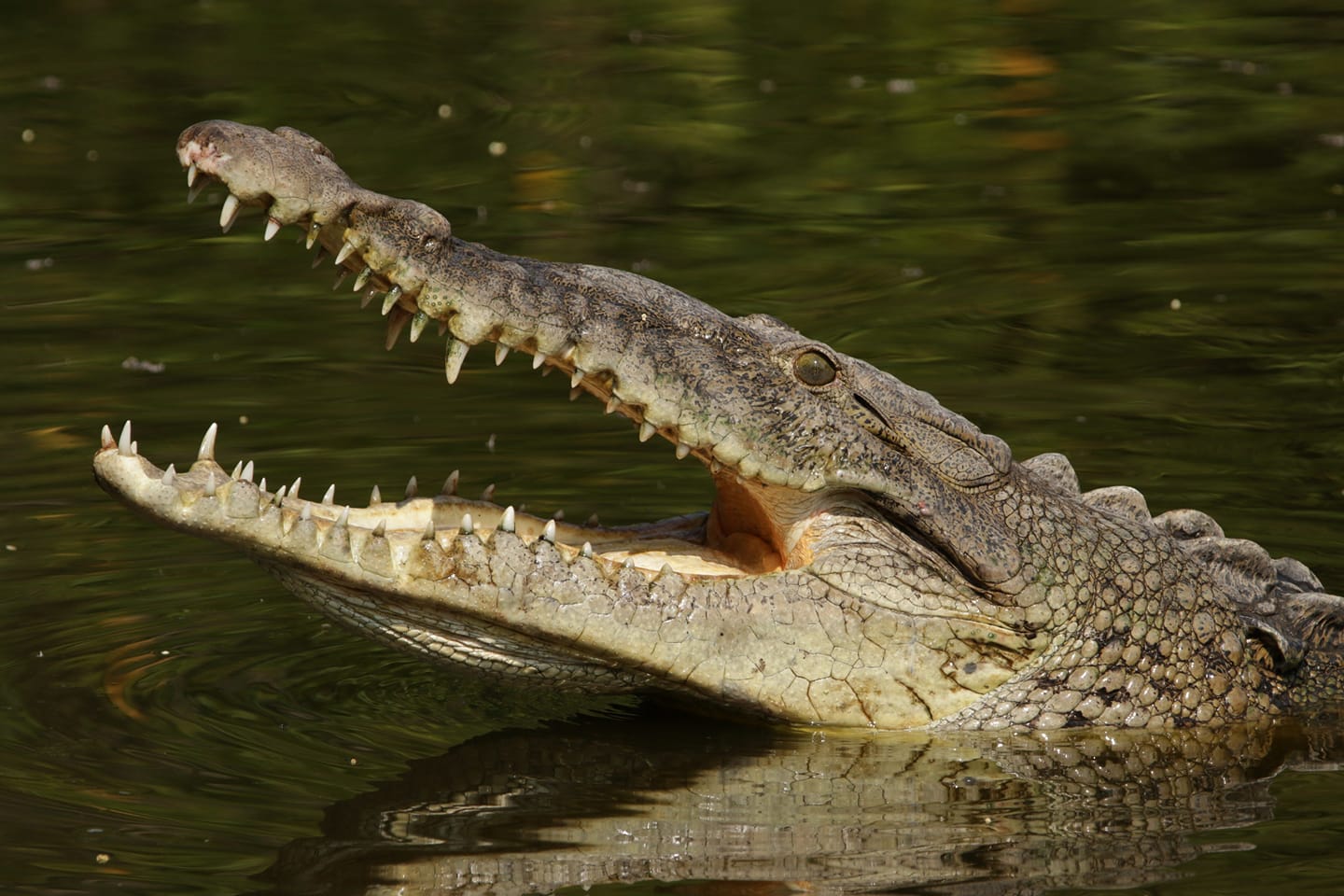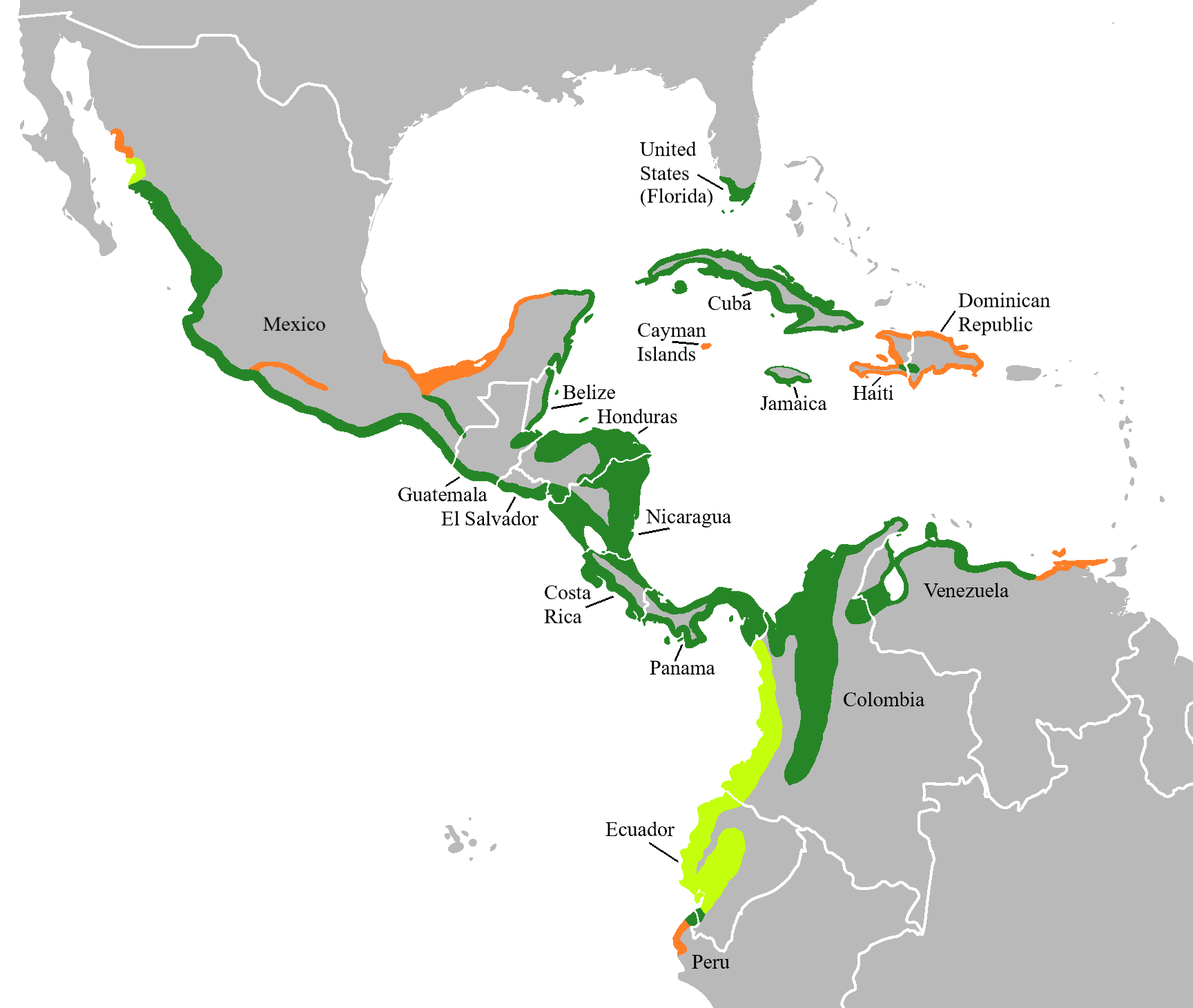American Crocodile, Crocodylus acutus


Distribution (see below for detailed information)
Belize, Cayman Islands (Extinct), Colombia, Costa Rica, Cuba, Dominican Republic, Ecuador, El Salvador, Guatemala, Haiti, Honduras, Jamaica, Mexico, Nicaragua, Panama, Peru, United States (Florida only), Venezuela
Red List Status
Vulnerable (VU)
Size
4-5 meters; exceptional individuals may exceed 5 meters
Threats
Habitat destruction; human population growth & expansion; persecution; human-crocodile conflict
Notes on Human-Crocodile Conflict
The American crocodile is responsible for the fourth highest numbers of attacks on humans of any crocodilian species and the highest in the New World. However, there is a massive drop-off in the numbers of attacks between the third highest (mugger crocodile) and the American crocodile, which is only responsible for between 1-6 human deaths annually. In individual years, the American alligator, black caiman or Morelet's crocodile may exceed it in the number of fatal attacks, but for the past decade the American crocodile has exceeded all other New World species.
Detailed Distribution
Belize
Present in coastal areas and most of the islands, including Ambergris Caye, Caye Caulker, Caye Chapel, Turneffe Atoll, and Lighthouse Reef, among others. On the mainland populations are much more restricted and largely hybridized with the Morelet's crocodile (C. moreletii). Attacks on humans are not a major issue in the country, with only three non-fatal incidents reported over the past decade.
Cayman Islands
American crocodiles were once present within the island chain and are likely the source of their name, though it is known that the Cuban crocodile (C. rhombifer) was also present at some point historically. Recently crocodiles have been captured in Old Man Bay (2.4 meter individual in 2006), Prospect Park (2009), and the ocean at Barkets National Park (2012). These crocodiles are likely to have been wandering individuals from Cuba or Mexico.
Colombia
There are recovering populations in several areas, including at various locations along much of the length of the Magdalena River, from the mouth to at least as far inland as Rio Bache in Huila. Some important locations include Cispata Bay and Rio Sinu, Honda Bay in Uribia, coastal Tayrona National Park, inland freshwater waterways in Paramillo National Park, and several inland rivers in North Santander including Rio Sardinata and Rio Nuevo Presidente. The status of the species along the Pacific coast is unknown, though a large individual was filmed in the ocean 40 miles from Punta Ardita of Jurado in Choco, near the border with Panama. Over the past decade 8 non-fatal attacks have been reported.
Costa Rica
Widely distributed on both coasts. Some important Pacific populations are found in the Rio Tempisque and its tributaries in Guanacaste, Rio Tarcoles, Rio Parrita, Rio Terraba, Rio Sierpe, Rio Coto, Corcovado National Park, and other locations on the Osa Peninsula. Caribbean coast population localities include Tortuguero National Park, Rio Matina, Rio Parismina, Rio Estrella, and Rio Sixaola along the border with Panama. Populations are found far inland along the Rio San Juan, including along tributaries such as Rio San Carlos, Rio Arenal, and Rio Frio. Costa Rica is second only to Mexico in the number of American crocodile attacks, with 25 reported (5 of them fatal) over the past decade.
Cuba
Found in suitable habitat from the Guanahacabibes peninsula in the west to Las Tunas in the northeast and Granma National Park in the southeast. An isolated population is also found in Laguna de Baconao west of Guantanamo Bay. Important locations include Rio Cuato and Zapata Swamp. Attacks on humans appear to be rare, though it is unclear to what degree incidents may go unreported.
Dominican Republic
Historical records exist for Puerto Plata and Rio Massacre along the northern border with Haiti. Today crocodiles are only found within Lago Enriquillo. Attacks do not appear to be a major issue, though two non-fatal incidents were reported in 2022 and 2023.
Ecuador
In historical times the species was probably present in most areas of suitable habitat. Today populations appear to be largely restricted to a few locations within the lower Rio Guayas and Rio Tumbes mangroves along the border with Peru. There are recent records of individual adult crocodiles from inland along the Rio Tumbes drainage in Loja. The status of the species elsewhere is poorly known, though crocodiles are occasionally reported from Rio Esmeraldas.
El Salvador
Historically the species was found in many areas, including inland freshwater habitat such as Lago de Guija and Laguna del Jocotal. Currently populations are found in the Zanjon El Chino wetlands and Barra de Santiago in San Francisco Menendez municipality, Jaltepeque estuary, Rio Lempa, Bahia de Jiquilisco, and Bahia de La Union. Four non-fatal attacks have been reported in San Francisco Menendez municipality over the past decade.
Guatemala
There is a record of a fatal attack in Canal de Chiquimulilla in Iztapa in 1960, but little else is known regarding the historical distribution of the species in Guatemala. Populations appear to persist along the Caribbean coast in portions of Rio Dulce (including El Golfete and Lago de Izabal), Rio Motagua, and Punta de Manabique, as well as possibly along the Pacific coast in Manchon Guamuchal. There have been no reports of American crocodile attacks in Guatemala in recent years, though there have been several incidents involving the Morelet's crocodile in inland habitat.
Haiti
Historically crocodiles were present in many areas including along the Tiburon Peninsula including the inland Lake Miragoane, Artibonite River, mangroves of the lower Rio Massacre, Trou Caiman Lake, and La Gonave Island. Today the species is likely restricted to the inland freshwater Lake Azuei/Etang Saumatre. No attacks on humans have been reported.
Honduras
Along the northern coast populations are present in the Ulua and Chamelecon rivers inland to El Cajon Dam, Rio Platano Biosphere Reserve, Caratasca Wildlife Reserve, Brus Laguna, and Rio Coco bordering Nicaragua. It is unclear if the population present in Lake Yojoa is extant. Pacific coast populations are found in the Gulf of Fonseca. Over the past decade four attacks have been reported, including one fatality in Brus Laguna and non-fatal incidents in the Ulua River, Roatan Island, and Marcovia.
Jamaica
Predominantly present along the southern coast, though small numbers are present in the north. Important locations include the Black River and Hellshire mangroves. Along the northern coast crocodiles have recently been reported from Falmouth, Montego Bay, and Lucea East River. 11 attacks have been reported over the past decade, including one fatality in Hellshire in 2018. Other recent attack locations include the Minho River, Yallahs River mouth, and Duhaney River in Kingston.
Mexico
Historically the species was found as far north as Rio Yaqui in Sonora state and as far inland as San Juan Totolcintla (where attacks occurred in the late 19th Century) along the Atoyac River in Guerrero state along the Pacific Coast. Today the northernmost Pacific population is found at the mouth of Rio Fuerto along the border between Sonora and Sinaloa, with populations found in every coastal state southward to the Guatemalan border. Important locations include the San Blas mangroves in Nayarit, Rio Tomatlan and Estero La Manzanilla in Jalisco, Lagunas de Chacahua in Oaxaca, and La Encrucijada Biosphere in Chiapas. Populations are even found in major tourist destinations, such as Puerto Vallarta, Zihuatanejo, and Acapulco. An isolated population is also known from Isla Maria Magdalena.
Along the Caribbean coast populations are found exclusively in coastal areas from the Belizean border northward through Cancun and possibly westward to Ria Lagartos. Island populations are known from Cozumel, Banco Chinchorro, and Isla Mujeres. While these island populations consist of genetically pure American crocodiles, the mainland populations are believed to be mostly hybridized with Morelet's crocodiles. American crocodiles are now extinct along the western Yucatan Peninsula (Campeche) an Gulf Coast, both of which now hold Morelet's crocodile populations in estuarine habitat. While the lower Rio Grijalva now consists entirely of Morelet's crocodiles, an inland relict population of American crocodiles is found in Malposo Dam, Chicoasen Dam, Sumidero Canyon, and La Angostura Dam. Mexico experiences by far the most attacks by American crocodiles range-wide, with 120 incidents (16 fatal) reported over the past decade, though attack frequency is decreasing.
Nicaragua
Along the Caribbean coast (Mosquito Coast) populations are found in Rio Coco, at least as far inland as Palacaguina in Madriz (the site of a non-fatal incident in 2011), as well as Rio Punta Gorda and Rio San Juan bordering Costa Rica inland to Lago Cocibolca (Nicaragua) and Lago Xolotlan (Managua). Along the Pacific coast populations are found in Rio Estero Real/Gulf of Fonseca, Padre Ramos Nature Reserve, Isla Juan Venado Nature Reserve, and Rio Tamarindo at Puerto Sandino. Since 2020 there have been reports of seven attacks, including one fatality along Rio Coco at Walakitan in Wiwili, Jinotega.
Panama
Along the Pacific coast populations are found in the Gulf of Montijo and various waterways in the Gulf of Parita including Rio Parita, Rio Santa Maria, Rio Estero Salado, and Rio Grande. In the Panama Canal populations are found in Lago Miraflores, Lago Gatun, and Rio Chagres. Further south along the Pacific populations are found in Rio Chepo (very far inland to Rio Canazas in Torti, Chepo District, where a fatal attack occurred in 2013) and Rio Tuira. The species also occurs on Coiba Island and in Islas Perlas. Along the Caribbean coast crocodiles are found in Laguna Chiriqui and various locations in Guna Yala including Rio Sugandi and Rio Gwidi. Over the past decade 11 attacks were reported, resulting in two deaths.
Peru
The southernmost extent of the American crocodile range along the Pacific coast. Historically populations were found as far south as Rio Chira, but today they are restricted to Rio Tumbes at the border with Ecuador. No attacks have been reported.
United States
In the USA the American crocodile is restricted to southern Florida, due to a lack of tolerance for the colder winter temperatures further north. The largest populations are currently found in southern Everglades National Park and in the canals of the Turkey Point nuclear power plant. The species is also found in Biscayne Bay and throughout the Keys. Individual crocodiles have been found further north, even as occasional residents in some areas (formerly in Sanibal Island and Lake Tarpon, for example). The northernmost record of a wandering individual is from the Isle of Palms near Charleston, South Carolina. Only one non-fatal incident (involving two victims) has been reported. It occurred in Coral Cables in 2014.
Venezuela
Populations are currently found from Lago de Maracaibo and the adjacent waterways in Cienagas de Juan Manuel National Park in the west through to the Boca de Uchire and Unare region in the east. The largest population is found in Laguna Tacarigua, but populations are also scattered at other locations including Pueblo Viejo Dam, Rio Tocuyo, Rio Yaracuy, and around Turiamo. Historically the species was present in Rio Manzanares in Cumana, on Isla de Margarita, and as far east as the Paria Peninsula. No attacks have been reported over the past decade, though a non-fatal incident was reported from Playa Majagua in Chirimena, Miranda in 2012.
